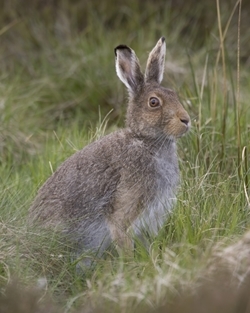 Mountain hares are part of the sporting interest on many upland Scottish estates, where they are found at high densities, benefiting from the production of cover, young heather and few predators. There has been a good deal of media activity recently as contemporary moorland management for red grouse, notably culling mountain hares to prevent tick-borne disease transmission, is raising concern over the long-term conservation status of the species. Our research over the last ten years and the data collected through the National Gamebag Census (NGC) allows us to inform the debate surrounding the conservation, ecology and management of mountain hares.
Mountain hares are part of the sporting interest on many upland Scottish estates, where they are found at high densities, benefiting from the production of cover, young heather and few predators. There has been a good deal of media activity recently as contemporary moorland management for red grouse, notably culling mountain hares to prevent tick-borne disease transmission, is raising concern over the long-term conservation status of the species. Our research over the last ten years and the data collected through the National Gamebag Census (NGC) allows us to inform the debate surrounding the conservation, ecology and management of mountain hares.
The law
EU legislation seeks to promote sustainable management of mountain hares, not protection per se. The EU requirement to monitor hares, now transcribed into Scottish law, was designed to track the status of fragile low-density mountain hares populations in continental Europe. In Scotland, a closed season has recently been introduced in line with other mammal species, although Scottish Natural Heritage has granted licences to cull during the closed season to prevent serious damage to trees.
Current status
Through the NGC, we can evaluate trends in mountain hare bags. Since the 1950s, when keepering increased again after World War II, the bags show a clear cyclical pattern of peaks and troughs. Despite these large short- and medium-term changes, there is no discernable long-term trend in numbers of hares in the bag. We established in 2008 that the Scottish range of mountain hare is not shrinking (range contraction is often the first sign of a population in trouble), and we are again working with SNH and the James Hutton Institute to assess hare densities more accurately.
Interpretation
Scottish mountain hare densities have regularly been ten times higher than are typical in continental Europe. Research suggests that hare numbers can fluctuate naturally for many reasons: parasites, weather, predation and habitat quality. Quoted by some authors as indicative of intensive control, apparently natural declines of ‘5-100 fold’ followed by recovery are a feature of bag records long before culls for disease control were an issue. This suggests that large bags indicate high hare abundance rather than high cull rates, and vice versa. However, research is needed to understand better how trends in bags are influenced by changes in cull effort.
Culling hares to manage disease
Our research suggests that hares should be part of tick disease control strategies that moorland managers use to support both grouse and hares. However, the specific management priority should be deer reduction hand-in-hand with treated sheep before considering hare culls. The highest risk when shooting hares is when they are already declining either naturally or through targeted management. Moors must then consult neighbours to make sure shooting and natural declines are not coupled across large landscape areas.
Sustainable management
The fact that we still commonly see hares even in areas where there are intensive culls suggests that the population may be more robust than some think. However, this cannot be taken for granted, and sustainable management of hares must go hand in hand with sustainable management of grouse. Improved monitoring methods would help us understand the effects of culls, with the NGC as a means of putting current hare bags in the context of past changes in bags. This is a sound evidence-based perspective for policy makers.
Dr. Adam Smith and Dr Kathy Fletcher
January 2014